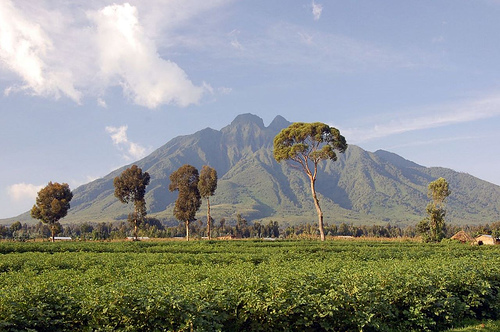

Location: Map
Area: 10,830 km²
Official site
Virunga National Park, located in the eastern Democratic Republic of the Congo (DRC), is Africa's oldest national park and one of the most biodiverse protected areas on the continent. Established in 1925, it spans approximately 3,000 square miles (7,800 square kilometers) and is renowned for its stunning landscapes, active volcanoes, and critical role in conserving endangered species like mountain gorillas. As a UNESCO World Heritage Site since 1979, it encompasses a remarkable range of habitats that surpass those of any other African park, making it a global treasure for biodiversity and natural wonders.
Virunga National Park lies in the Albertine Rift Valley, bordering
Rwanda and Uganda to the east. Its terrain is extraordinarily varied,
featuring active volcanoes such as Mount Nyiragongo and Mount
Nyamuragira, which are part of the Virunga Mountains chain—the only
place on Earth where such volcanic activity coexists with glaciers on
nearby peaks like those in the Rwenzori Mountains. The park includes
misty rainforests, open savannahs, alpine meadows, swamps, and lakes
such as Lake Edward. Elevations range from about 680 meters (2,230 feet)
in the Semliki Valley to over 5,100 meters (16,700 feet) at the summit
of Mount Stanley in the Rwenzoris. This diversity creates microclimates
that support an array of ecosystems, from lowland forests to
high-altitude moorlands, all within a region influenced by the Congo
Basin and the Great Rift Valley.
The park's volcanic soils are
fertile, contributing to lush vegetation, but the area is also prone to
natural hazards like eruptions—Nyiragongo's 2002 eruption destroyed
parts of Goma, a nearby city, and lava flows remain a ongoing feature.
Rivers and lakes within the park, including the Rutshuru River and Lake
Edward, form vital waterways that connect to the Nile River system,
underscoring its hydrological importance.
Virunga was founded on April 21, 1925, as Albert National Park by
Belgian colonial authorities, primarily to protect mountain gorillas
discovered by European explorers in the early 20th century. It was
Africa's first national park and was expanded over the decades to
include more habitats. In 1969, it was renamed Virunga National Park
following Congo's independence. The park gained UNESCO status in 1979
but was placed on the List of World Heritage in Danger in 1994 due to
armed conflict, poaching, and deforestation.
Throughout the late 20th
and early 21st centuries, Virunga has been embroiled in regional
conflicts, including the Rwandan genocide spillover in the 1990s and
ongoing militia activities. Despite these challenges, it marked its
centennial in 2025, with commemorations including publications like the
book "Virunga, 100 Years of an Exceptional Park." Management shifted in
2008 to a public-private partnership with the European Union and Howard
G. Buffett Foundation, leading to innovative conservation models.
Virunga is home to an unparalleled array of species, with over 2,000
plant species, 706 bird species, and 218 mammal species, making it one
of the most biologically diverse areas in Africa.
It protects 44
endangered species, including about one-quarter of the world's remaining
mountain gorillas (around 200 individuals in the park out of a global
population of approximately 880). Other primates include eastern lowland
gorillas, chimpanzees, and various monkeys like the golden monkey.
Mammals range from forest elephants and okapi (a relative of the giraffe
endemic to the Congo) to savannah species like lions, buffalo, hippos,
and antelopes such as topi and kob. The park's avian diversity includes
endemics like the Rwenzori turaco and Grauer's broadbill, while reptiles
and amphibians thrive in its wetlands. Vegetation zones include bamboo
forests, Afro-montane forests, and papyrus swamps, supporting this
richness.
Conservation in Virunga is managed by the Institut Congolais pour la
Conservation de la Nature (ICCN) in partnership with the Virunga
Foundation. The Virunga Alliance integrates protection with community
development, creating over 11,000 jobs in eco-tourism, sustainable
agriculture, and renewable energy. Initiatives include hydroelectric
plants supplying clean power to 70% of Goma and water access for 300,000
people. Anti-poaching patrols, involving over 1,000 rangers, have helped
stabilize gorilla populations through intensive monitoring and habitat
restoration.
Projects like cocoa farming near the park support local
economies while reducing pressure on forests, and products like
"Chocolate Gorilla" fund ranger efforts. International support from
organizations like Re:wild and WWF emphasizes sustainable development to
foster peace.
Virunga faces severe threats from armed conflict, with militias controlling parts of the park and surrounding areas. Over 200 rangers have been killed since 1996, including more than 20 in the past year alone. Poaching, illegal charcoal production, and oil exploration (despite a moratorium) exacerbate habitat loss. Population pressures from refugees and local communities lead to encroachment, while climate change affects volcanic activity and water resources. Despite these, the park's model of linking conservation to economic benefits aims to mitigate conflicts.
Tourism is a cornerstone of Virunga's sustainable model, offering gorilla trekking, volcano hikes to Nyiragongo's lava lake, chimpanzee habituation walks, and birdwatching safaris. Lodges like Mikeno Lodge provide luxury accommodations, with proceeds funding conservation. However, travel advisories due to insecurity often limit access; visitors must check current conditions via the official site. Eco-tourism generates revenue while employing locals as guides and rangers, promoting community buy-in.
As of 2025, Virunga celebrated its 100th anniversary amid ongoing efforts to expand green energy and agriculture projects. Gorilla populations continue to grow thanks to conservation, but rebel activities persist, underscoring the urgency of international support. The park remains a symbol of resilience, balancing natural preservation with human development in one of Africa's most volatile regions.